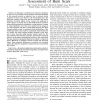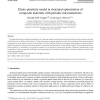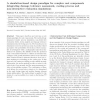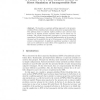102
Voted
MOC
2011
14 years 7 months ago
2011
Abstract. Local energy error estimates for the finite element method for elliptic problems were originally proved in 1974 by Nitsche and Schatz. These estimates show that the loca...
118
click to vote
PROCEDIA
2010
14 years 10 months ago
2010
High quality meshes are crucial for the solution of partial differential equations (PDEs) via the finite element method (or other PDE solvers). The accuracy of the PDE solution,...
TMI
1998
15 years 7 hour ago
1998
—In this paper a method for the objective assessment of burn scars is proposed. The quantitative measures developed in this research provide an objective way to calculate elastic...
141
click to vote
IJCV
1998
15 years 1 days ago
1998
We describe a new method for computing the displacement vector field in time sequences of 2D or 3D images (4D data). The method is energy-minimizing on the space of correspondence...
MCS
2007
Springer
15 years 7 days ago
2007
Springer
The paper deals with a structural optimization of composite materials with periodic microstructures invoking an elasto-plasticity model with the von Mises yield criterion. Closest...
EWC
2007
15 years 9 days ago
2007
This paper describes and exercises a new design paradigm for cast components. The methodology integrates foundry process simulation, non-destructive evaluation (nde), stress analys...
106
click to vote
SIGGRAPH
1993
ACM
15 years 4 months ago
1993
ACM
Many of the current radiosity algorithms create a piecewise constant approximation to the actual radiosity. Through interpolation and extrapolation, a continuous solution is obtai...
ISIPTA
2003
IEEE
15 years 5 months ago
2003
IEEE
The finite element method is widely used for solving various problems in geotechnical engineering practice. The input parameters required for the calculations are generally impre...
110
click to vote
MICCAI
2004
Springer
15 years 5 months ago
2004
Springer
Abstract. We introduce a new, efficient approach for modelling the deformation of organs following surgical cuts, retractions, and resections. It uses the extended finite element ...
106
Voted
EUROPAR
2004
Springer
15 years 5 months ago
2004
Springer
Abstract. We describe a consistent splitting approach to the pressurestabilized Petrov-Galerkin finite element method for incompressible flow. The splitting leads to (almost) exp...








